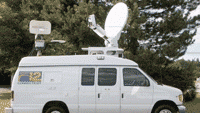Satellite/ENG systems

Finding money for anything these days is a struggle, and like anything else, the spending on trucks is likely to have several digits before the decimal point. But let's say your general manager has given you the opportunity of coming up with a wish list for an SNG truck, ENG van or remote semi-trailer. There have been a number of new developments in the last year or so. What could you find to spend money on?
The Wolf Coach ENG/SNG van offers hybrid terrestrial RF transmit and digital Ku uplink capabilities in a smaller-profile unit.
You could do what many stations are doing and take the opportunity to refurbish and upgrade an existing vehicle. In the last year or so there has been a dramatic rise in the requests for complete rebuilds and refurbishment of existing SNG and ENG trucks, as well as remote trailers. Based on your market topography, why not convert your aging ENG van with a digital COFDM microwave link, even though it will, of course, have an associated cost at your receiver sites. If the van needs a new mast, why not add COFDM digital transmit capability to your terrestrial RF path and maybe eliminate the need for that hazardous telescopic mast?
The upgrade to digital capability on existing SNG trucks has also been an attraction for many. You could turn your SNG truck into a “hybrid,” where you fit a short mast with a COFDM link to extend the truck's newsgathering capabilities. If you're looking for a new vehicle, there is a momentum for hybrid terrestrial RF transmit and digital Ku uplink capabilities in a smaller-profile unit such as a van. The van-sized unit is very maneuverable in all markets and can be more energy efficient. The digital Ku path is less costly on airtime, with more efficient use of rack space. Wolf Coach is one of a number of manufacturers who offer this type of rig.
For larger SNG/EFP units, some truck builders offer under-floor generators. This offers the facility the option of removing the onboard generator from that valuable operational area and slinging it under the chassis to achieve space savings and reduce noise levels inside the operational area. Some customers want an engine-driven PTO and an under-floor generator, giving them both backup and the ability to sell power to the poor guy in the truck pool whose generator has just died on him!
Compression
You no longer need to allow 2RU or more of rack space for a separate MPEG-2 encoder and modulator. Compact 1RU high MPEG-2 encoder/modulators have been appearing over the last year from a number of manufacturers, including Scopus with their E1700 and Tandberg with the E5714. Standard offers the 1RU high but only half-rack-width L1000 encoder/modulator. Advent Communications has just introduced a 1RU encoder/modulator/upconverter, with a choice of L-, C- or Ku-band outputs. In the Ku-band unit, the uplink chain is virtually in one box apart from the HPA. You don't have to worry about one part failing and the whole thing becoming useless — you just carry a spare 1RU unit in the back!
The professional video industry's #1 source for news, trends and product and tech information. Sign up below.
What about that hot topic — the use of opportunistic data? Tandberg is targeting the DSNG market by offering two-way connectivity with an IP encapsulator. This allows an SNG truck in the field to be connected to the station's LAN, so IP LAN traffic can be transmitted over the same MPEG-2 circuit as the video traffic. This gives high-speed data transfer or network access “for free” at the remote location, potentially giving journalists remote access to their e-mail or to the newsroom system to file stories. This certainly beats the problem of not even getting a cell phone connection when all the cells are jammed at that breaking news story.
Tandberg also sells a unique (but proprietary) system of signal pre-correction called PreKor, i.e., pre-distorting the signal to overcome the non-linearity when you drive the TWT very hard. Their solution for correcting distortion in SCPC satellite links can increase data capacity using either QPSK, 8PSK or 16QAM modulation. In addition, Tandberg claims the system improves 16QAM link budgets, typically by 4- to 6dB. Overall, the system is claimed to optimize the quality, power and capacity of the signal at the output of the satellite.
Telecast Fiber’s compact digital ENG/SNG CopperHead camera fiber analog multiplexer is now available for SDI and HDTV cameras.
Light over copper
Covering both ENG and EFP is the use of fiber optic to connect cameras to trucks. While it's been around for over five years in a form applicable to ENG/EFP, the development has now extended to HD. Telecast Fiber's compact digital ENG/SNG CopperHead camera fiber analog multiplexer was one of the hits of NAB 2001, and is now available for SDI and HDTV cameras. Fitted with a heavy-duty two-fiber connector, the multiplexer is available with an optional uncompressed 1.5Gb/s HD or 270Mb/s SDI channel. All camera signals — HD/SDI program video, analog program video, dual program audio, intercom, tally call, return video, genlock, CCU data and auxiliary data — are on a single tactical grade fiber cable.
For EFP, Telecast's Viper II multiplexer system offers digitally multiplexed HD video, SDI video, AES/EBU audio and analog audio channels. Coarse wavelength-division multiplexing (CWDM) combines light signals from different lasers onto one fiber, so add eight-channel CWDM capability and you can stack up tens of video and audio channels onto a single fiber that's a little over one-fourth of an inch in total diameter. This is a heavy-duty transport system, and though it's not cheap, what's the harm in adding it to your wish list? This stuff is quick to rig, and even field repairs are not the nightmare they used to be.
Wires … what wires?
For EFP applications, the attraction of truly mobile digital wireless cameras without the risk of blind spots or breakups in the stadium are a TD's dream. A number of manufacturers are now marketing digital MPEG/COFDM/RF wireless camera packs that offer just this — the BMS CarryCoder, Tandberg Voyager Lite and Gigawave, to mention a few. What about the delay? The video from the cabled goal camera showing the ball hitting the back of the net, followed by the wireless touchline camera showing a picture half a second back in time is enough to send shudders down any TD's spine. Well, the delay is now better — a lot better. With some of these digital camera packs, the delay is down to only two or three frames. One frame would be better — and it will come.
Laser links has come a long way in the last few years. The Canobeam-2 laser link can be set up in minutes, and requires no FCC license or frequency allocation. These benefits, along with auto-tracking and no RF interference, make it easy to transmit bi-directional HD or SD digital video and audio signals. This is just the thing for connecting that remote camera at the top of the stadium without interference from your neighbors.
So there are some ideas for your wish list — now just scare up the money!
Jonathan Higgins is a satellite communications consultant and author of “Satellite Newsgathering,” available from many book dealers.
